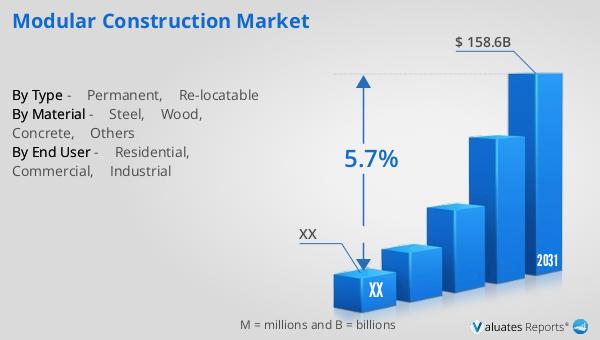LIST OF TABLES
TABLE 01. GLOBAL MODULAR CONSTRUCTION MARKET, BY TYPE, 2021-2031 ($MILLION)
TABLE 02. MODULAR CONSTRUCTION MARKET FOR PERMANENT, BY REGION, 2021-2031 ($MILLION)
TABLE 03. MODULAR CONSTRUCTION MARKET FOR RE-LOCATABLE, BY REGION, 2021-2031 ($MILLION)
TABLE 04. GLOBAL MODULAR CONSTRUCTION MARKET, BY MATERIAL, 2021-2031 ($MILLION)
TABLE 05. MODULAR CONSTRUCTION MARKET FOR STEEL, BY REGION, 2021-2031 ($MILLION)
TABLE 06. MODULAR CONSTRUCTION MARKET FOR WOOD, BY REGION, 2021-2031 ($MILLION)
TABLE 07. MODULAR CONSTRUCTION MARKET FOR CONCRETE, BY REGION, 2021-2031 ($MILLION)
TABLE 08. MODULAR CONSTRUCTION MARKET FOR OTHERS, BY REGION, 2021-2031 ($MILLION)
TABLE 09. GLOBAL MODULAR CONSTRUCTION MARKET, BY END USER, 2021-2031 ($MILLION)
TABLE 10. MODULAR CONSTRUCTION MARKET FOR RESIDENTIAL, BY REGION, 2021-2031 ($MILLION)
TABLE 11. MODULAR CONSTRUCTION MARKET FOR COMMERCIAL, BY REGION, 2021-2031 ($MILLION)
TABLE 12. MODULAR CONSTRUCTION MARKET FOR INDUSTRIAL, BY REGION, 2021-2031 ($MILLION)
TABLE 13. MODULAR CONSTRUCTION MARKET, BY REGION, 2021-2031 ($MILLION)
TABLE 14. NORTH AMERICA MODULAR CONSTRUCTION MARKET, BY TYPE, 2021-2031 ($MILLION)
TABLE 15. NORTH AMERICA MODULAR CONSTRUCTION MARKET, BY MATERIAL, 2021-2031 ($MILLION)
TABLE 16. NORTH AMERICA MODULAR CONSTRUCTION MARKET, BY END USER, 2021-2031 ($MILLION)
TABLE 17. NORTH AMERICA MODULAR CONSTRUCTION MARKET, BY COUNTRY, 2021-2031 ($MILLION)
TABLE 18. U.S. MODULAR CONSTRUCTION MARKET, BY TYPE, 2021-2031 ($MILLION)
TABLE 19. U.S. MODULAR CONSTRUCTION MARKET, BY MATERIAL, 2021-2031 ($MILLION)
TABLE 20. U.S. MODULAR CONSTRUCTION MARKET, BY END USER, 2021-2031 ($MILLION)
TABLE 21. CANADA MODULAR CONSTRUCTION MARKET, BY TYPE, 2021-2031 ($MILLION)
TABLE 22. CANADA MODULAR CONSTRUCTION MARKET, BY MATERIAL, 2021-2031 ($MILLION)
TABLE 23. CANADA MODULAR CONSTRUCTION MARKET, BY END USER, 2021-2031 ($MILLION)
TABLE 24. MEXICO MODULAR CONSTRUCTION MARKET, BY TYPE, 2021-2031 ($MILLION)
TABLE 25. MEXICO MODULAR CONSTRUCTION MARKET, BY MATERIAL, 2021-2031 ($MILLION)
TABLE 26. MEXICO MODULAR CONSTRUCTION MARKET, BY END USER, 2021-2031 ($MILLION)
TABLE 27. EUROPE MODULAR CONSTRUCTION MARKET, BY TYPE, 2021-2031 ($MILLION)
TABLE 28. EUROPE MODULAR CONSTRUCTION MARKET, BY MATERIAL, 2021-2031 ($MILLION)
TABLE 29. EUROPE MODULAR CONSTRUCTION MARKET, BY END USER, 2021-2031 ($MILLION)
TABLE 30. EUROPE MODULAR CONSTRUCTION MARKET, BY COUNTRY, 2021-2031 ($MILLION)
TABLE 31. GERMANY MODULAR CONSTRUCTION MARKET, BY TYPE, 2021-2031 ($MILLION)
TABLE 32. GERMANY MODULAR CONSTRUCTION MARKET, BY MATERIAL, 2021-2031 ($MILLION)
TABLE 33. GERMANY MODULAR CONSTRUCTION MARKET, BY END USER, 2021-2031 ($MILLION)
TABLE 34. FRANCE MODULAR CONSTRUCTION MARKET, BY TYPE, 2021-2031 ($MILLION)
TABLE 35. FRANCE MODULAR CONSTRUCTION MARKET, BY MATERIAL, 2021-2031 ($MILLION)
TABLE 36. FRANCE MODULAR CONSTRUCTION MARKET, BY END USER, 2021-2031 ($MILLION)
TABLE 37. UK MODULAR CONSTRUCTION MARKET, BY TYPE, 2021-2031 ($MILLION)
TABLE 38. UK MODULAR CONSTRUCTION MARKET, BY MATERIAL, 2021-2031 ($MILLION)
TABLE 39. UK MODULAR CONSTRUCTION MARKET, BY END USER, 2021-2031 ($MILLION)
TABLE 40. ITALY MODULAR CONSTRUCTION MARKET, BY TYPE, 2021-2031 ($MILLION)
TABLE 41. ITALY MODULAR CONSTRUCTION MARKET, BY MATERIAL, 2021-2031 ($MILLION)
TABLE 42. ITALY MODULAR CONSTRUCTION MARKET, BY END USER, 2021-2031 ($MILLION)
TABLE 43. REST OF EUROPE MODULAR CONSTRUCTION MARKET, BY TYPE, 2021-2031 ($MILLION)
TABLE 44. REST OF EUROPE MODULAR CONSTRUCTION MARKET, BY MATERIAL, 2021-2031 ($MILLION)
TABLE 45. REST OF EUROPE MODULAR CONSTRUCTION MARKET, BY END USER, 2021-2031 ($MILLION)
TABLE 46. ASIA-PACIFIC MODULAR CONSTRUCTION MARKET, BY TYPE, 2021-2031 ($MILLION)
TABLE 47. ASIA-PACIFIC MODULAR CONSTRUCTION MARKET, BY MATERIAL, 2021-2031 ($MILLION)
TABLE 48. ASIA-PACIFIC MODULAR CONSTRUCTION MARKET, BY END USER, 2021-2031 ($MILLION)
TABLE 49. ASIA-PACIFIC MODULAR CONSTRUCTION MARKET, BY COUNTRY, 2021-2031 ($MILLION)
TABLE 50. CHINA MODULAR CONSTRUCTION MARKET, BY TYPE, 2021-2031 ($MILLION)
TABLE 51. CHINA MODULAR CONSTRUCTION MARKET, BY MATERIAL, 2021-2031 ($MILLION)
TABLE 52. CHINA MODULAR CONSTRUCTION MARKET, BY END USER, 2021-2031 ($MILLION)
TABLE 53. JAPAN MODULAR CONSTRUCTION MARKET, BY TYPE, 2021-2031 ($MILLION)
TABLE 54. JAPAN MODULAR CONSTRUCTION MARKET, BY MATERIAL, 2021-2031 ($MILLION)
TABLE 55. JAPAN MODULAR CONSTRUCTION MARKET, BY END USER, 2021-2031 ($MILLION)
TABLE 56. SOUTH KOREA MODULAR CONSTRUCTION MARKET, BY TYPE, 2021-2031 ($MILLION)
TABLE 57. SOUTH KOREA MODULAR CONSTRUCTION MARKET, BY MATERIAL, 2021-2031 ($MILLION)
TABLE 58. SOUTH KOREA MODULAR CONSTRUCTION MARKET, BY END USER, 2021-2031 ($MILLION)
TABLE 59. INDIA MODULAR CONSTRUCTION MARKET, BY TYPE, 2021-2031 ($MILLION)
TABLE 60. INDIA MODULAR CONSTRUCTION MARKET, BY MATERIAL, 2021-2031 ($MILLION)
TABLE 61. INDIA MODULAR CONSTRUCTION MARKET, BY END USER, 2021-2031 ($MILLION)
TABLE 62. REST OF ASIA-PACIFIC MODULAR CONSTRUCTION MARKET, BY TYPE, 2021-2031 ($MILLION)
TABLE 63. REST OF ASIA-PACIFIC MODULAR CONSTRUCTION MARKET, BY MATERIAL, 2021-2031 ($MILLION)
TABLE 64. REST OF ASIA-PACIFIC MODULAR CONSTRUCTION MARKET, BY END USER, 2021-2031 ($MILLION)
TABLE 65. LAMEA MODULAR CONSTRUCTION MARKET, BY TYPE, 2021-2031 ($MILLION)
TABLE 66. LAMEA MODULAR CONSTRUCTION MARKET, BY MATERIAL, 2021-2031 ($MILLION)
TABLE 67. LAMEA MODULAR CONSTRUCTION MARKET, BY END USER, 2021-2031 ($MILLION)
TABLE 68. LAMEA MODULAR CONSTRUCTION MARKET, BY COUNTRY, 2021-2031 ($MILLION)
TABLE 69. LATIN AMERICA MODULAR CONSTRUCTION MARKET, BY TYPE, 2021-2031 ($MILLION)
TABLE 70. LATIN AMERICA MODULAR CONSTRUCTION MARKET, BY MATERIAL, 2021-2031 ($MILLION)
TABLE 71. LATIN AMERICA MODULAR CONSTRUCTION MARKET, BY END USER, 2021-2031 ($MILLION)
TABLE 72. MIDDLE EAST MODULAR CONSTRUCTION MARKET, BY TYPE, 2021-2031 ($MILLION)
TABLE 73. MIDDLE EAST MODULAR CONSTRUCTION MARKET, BY MATERIAL, 2021-2031 ($MILLION)
TABLE 74. MIDDLE EAST MODULAR CONSTRUCTION MARKET, BY END USER, 2021-2031 ($MILLION)
TABLE 75. AFRICA MODULAR CONSTRUCTION MARKET, BY TYPE, 2021-2031 ($MILLION)
TABLE 76. AFRICA MODULAR CONSTRUCTION MARKET, BY MATERIAL, 2021-2031 ($MILLION)
TABLE 77. AFRICA MODULAR CONSTRUCTION MARKET, BY END USER, 2021-2031 ($MILLION)
TABLE 78. ATCO LTD.: KEY EXECUTIVES
TABLE 79. ATCO LTD.: COMPANY SNAPSHOT
TABLE 80. ATCO LTD.: PRODUCT SEGMENTS
TABLE 81. ATCO LTD.: PRODUCT PORTFOLIO
TABLE 82. BECHTEL CORPORATION: KEY EXECUTIVES
TABLE 83. BECHTEL CORPORATION: COMPANY SNAPSHOT
TABLE 84. BECHTEL CORPORATION: PRODUCT SEGMENTS
TABLE 85. BECHTEL CORPORATION: PRODUCT PORTFOLIO
TABLE 86. GIANT CONTAINERS INC.: KEY EXECUTIVES
TABLE 87. GIANT CONTAINERS INC.: COMPANY SNAPSHOT
TABLE 88. GIANT CONTAINERS INC.: SERVICE SEGMENTS
TABLE 89. GIANT CONTAINERS INC.: PRODUCT PORTFOLIO
TABLE 90. HONOMOBO CORPORATION: KEY EXECUTIVES
TABLE 91. HONOMOBO CORPORATION: COMPANY SNAPSHOT
TABLE 92. HONOMOBO CORPORATION: PRODUCT SEGMENTS
TABLE 93. HONOMOBO CORPORATION: PRODUCT PORTFOLIO
TABLE 94. LENDLEASE CORPORATION: KEY EXECUTIVES
TABLE 95. LENDLEASE CORPORATION: COMPANY SNAPSHOT
TABLE 96. LENDLEASE CORPORATION: PRODUCT SEGMENTS
TABLE 97. LENDLEASE CORPORATION: PRODUCT PORTFOLIO
TABLE 98. LENDLEASE CORPORATION: KEY STRATERGIES
TABLE 99. SG BLOCKS, INC.: KEY EXECUTIVES
TABLE 100. SG BLOCKS, INC.: COMPANY SNAPSHOT
TABLE 101. SG BLOCKS, INC.: PRODUCT SEGMENTS
TABLE 102. SG BLOCKS, INC.: PRODUCT PORTFOLIO
TABLE 103. SKANSKA AB: KEY EXECUTIVES
TABLE 104. SKANSKA AB: COMPANY SNAPSHOT
TABLE 105. SKANSKA AB: SERVICE SEGMENTS
TABLE 106. SKANSKA AB: PRODUCT PORTFOLIO
TABLE 107. SPEED HOUSE GROUP OF COMPANIES: KEY EXECUTIVES
TABLE 108. SPEED HOUSE GROUP OF COMPANIES: COMPANY SNAPSHOT
TABLE 109. SPEED HOUSE GROUP OF COMPANIES: SERVICE SEGMENTS
TABLE 110. SPEED HOUSE GROUP OF COMPANIES: PRODUCT PORTFOLIO
TABLE 111. SUPERTECH INDUSTRIES: KEY EXECUTIVES
TABLE 112. SUPERTECH INDUSTRIES: COMPANY SNAPSHOT
TABLE 113. SUPERTECH INDUSTRIES: PRODUCT SEGMENTS
TABLE 114. SUPERTECH INDUSTRIES: PRODUCT PORTFOLIO
TABLE 115. TEMPOHOUSING: KEY EXECUTIVES
TABLE 116. TEMPOHOUSING: COMPANY SNAPSHOT
TABLE 117. TEMPOHOUSING: PRODUCT SEGMENTS
TABLE 118. TEMPOHOUSING: PRODUCT PORTFOLIO LIST OF FIGURES
FIGURE 01. MODULAR CONSTRUCTION MARKET, 2021-2031
FIGURE 02. SEGMENTATION OF MODULAR CONSTRUCTION MARKET, 2021-2031
FIGURE 03. TOP INVESTMENT POCKETS IN MODULAR CONSTRUCTION MARKET (2022-2031)
FIGURE 04. LOW BARGAINING POWER OF SUPPLIERS
FIGURE 05. LOW BARGAINING POWER OF BUYERS
FIGURE 06. LOW THREAT OF SUBSTITUTES
FIGURE 07. LOW THREAT OF NEW ENTRANTS
FIGURE 08. LOW INTENSITY OF RIVALRY
FIGURE 09. DRIVERS, RESTRAINTS AND OPPORTUNITIES: GLOBALMODULAR CONSTRUCTION MARKET
FIGURE 10. MODULAR CONSTRUCTION MARKET, BY TYPE, 2021(%)
FIGURE 11. COMPARATIVE SHARE ANALYSIS OF MODULAR CONSTRUCTION MARKET FOR PERMANENT, BY COUNTRY 2021-2031(%)
FIGURE 12. COMPARATIVE SHARE ANALYSIS OF MODULAR CONSTRUCTION MARKET FOR RE-LOCATABLE, BY COUNTRY 2021-2031(%)
FIGURE 13. MODULAR CONSTRUCTION MARKET, BY MATERIAL, 2021(%)
FIGURE 14. COMPARATIVE SHARE ANALYSIS OF MODULAR CONSTRUCTION MARKET FOR STEEL, BY COUNTRY 2021-2031(%)
FIGURE 15. COMPARATIVE SHARE ANALYSIS OF MODULAR CONSTRUCTION MARKET FOR WOOD, BY COUNTRY 2021-2031(%)
FIGURE 16. COMPARATIVE SHARE ANALYSIS OF MODULAR CONSTRUCTION MARKET FOR CONCRETE, BY COUNTRY 2021-2031(%)
FIGURE 17. COMPARATIVE SHARE ANALYSIS OF MODULAR CONSTRUCTION MARKET FOR OTHERS, BY COUNTRY 2021-2031(%)
FIGURE 18. MODULAR CONSTRUCTION MARKET, BY END USER, 2021(%)
FIGURE 19. COMPARATIVE SHARE ANALYSIS OF MODULAR CONSTRUCTION MARKET FOR RESIDENTIAL, BY COUNTRY 2021-2031(%)
FIGURE 20. COMPARATIVE SHARE ANALYSIS OF MODULAR CONSTRUCTION MARKET FOR COMMERCIAL, BY COUNTRY 2021-2031(%)
FIGURE 21. COMPARATIVE SHARE ANALYSIS OF MODULAR CONSTRUCTION MARKET FOR INDUSTRIAL, BY COUNTRY 2021-2031(%)
FIGURE 22. MODULAR CONSTRUCTION MARKET BY REGION, 2021
FIGURE 23. U.S. MODULAR CONSTRUCTION MARKET, 2021-2031 ($MILLION)
FIGURE 24. CANADA MODULAR CONSTRUCTION MARKET, 2021-2031 ($MILLION)
FIGURE 25. MEXICO MODULAR CONSTRUCTION MARKET, 2021-2031 ($MILLION)
FIGURE 26. GERMANY MODULAR CONSTRUCTION MARKET, 2021-2031 ($MILLION)
FIGURE 27. FRANCE MODULAR CONSTRUCTION MARKET, 2021-2031 ($MILLION)
FIGURE 28. UK MODULAR CONSTRUCTION MARKET, 2021-2031 ($MILLION)
FIGURE 29. ITALY MODULAR CONSTRUCTION MARKET, 2021-2031 ($MILLION)
FIGURE 30. REST OF EUROPE MODULAR CONSTRUCTION MARKET, 2021-2031 ($MILLION)
FIGURE 31. CHINA MODULAR CONSTRUCTION MARKET, 2021-2031 ($MILLION)
FIGURE 32. JAPAN MODULAR CONSTRUCTION MARKET, 2021-2031 ($MILLION)
FIGURE 33. SOUTH KOREA MODULAR CONSTRUCTION MARKET, 2021-2031 ($MILLION)
FIGURE 34. INDIA MODULAR CONSTRUCTION MARKET, 2021-2031 ($MILLION)
FIGURE 35. REST OF ASIA-PACIFIC MODULAR CONSTRUCTION MARKET, 2021-2031 ($MILLION)
FIGURE 36. LATIN AMERICA MODULAR CONSTRUCTION MARKET, 2021-2031 ($MILLION)
FIGURE 37. MIDDLE EAST MODULAR CONSTRUCTION MARKET, 2021-2031 ($MILLION)
FIGURE 38. AFRICA MODULAR CONSTRUCTION MARKET, 2021-2031 ($MILLION)
FIGURE 39. TOP WINNING STRATEGIES, BY YEAR
FIGURE 40. TOP WINNING STRATEGIES, BY DEVELOPMENT
FIGURE 41. TOP WINNING STRATEGIES, BY COMPANY
FIGURE 42. PRODUCT MAPPING OF TOP 10 PLAYERS
FIGURE 43. COMPETITIVE DASHBOARD
FIGURE 44. COMPETITIVE HEATMAP: MODULAR CONSTRUCTION MARKET
FIGURE 45. TOP PLAYER POSITIONING, 2021
FIGURE 46. ATCO LTD.: NET REVENUE, 2019-2021 ($MILLION)
FIGURE 47. ATCO LTD.: REVENUE SHARE BY SEGMENT, 2021 (%)
FIGURE 48. ATCO LTD.: REVENUE SHARE BY REGION, 2021 (%)
FIGURE 49. BECHTEL CORPORATION: NET REVENUE, 2019-2021 ($MILLION)
FIGURE 50. LENDLEASE CORPORATION: NET REVENUE, 2020-2022 ($MILLION)
FIGURE 51. LENDLEASE CORPORATION: REVENUE SHARE BY SEGMENT, 2022 (%)
FIGURE 52. LENDLEASE CORPORATION: REVENUE SHARE BY REGION, 2022 (%)
FIGURE 53. SG BLOCKS, INC.: NET REVENUE, 2019-2021 ($MILLION)
FIGURE 54. SG BLOCKS, INC.: REVENUE SHARE BY SEGMENT, 2021 (%)
FIGURE 55. SKANSKA AB: NET REVENUE, 2019-2021 ($MILLION)
FIGURE 56. SKANSKA AB: REVENUE SHARE BY SEGMENT, 2021 (%)
FIGURE 57. SKANSKA AB: REVENUE SHARE BY REGION, 2021 (%


